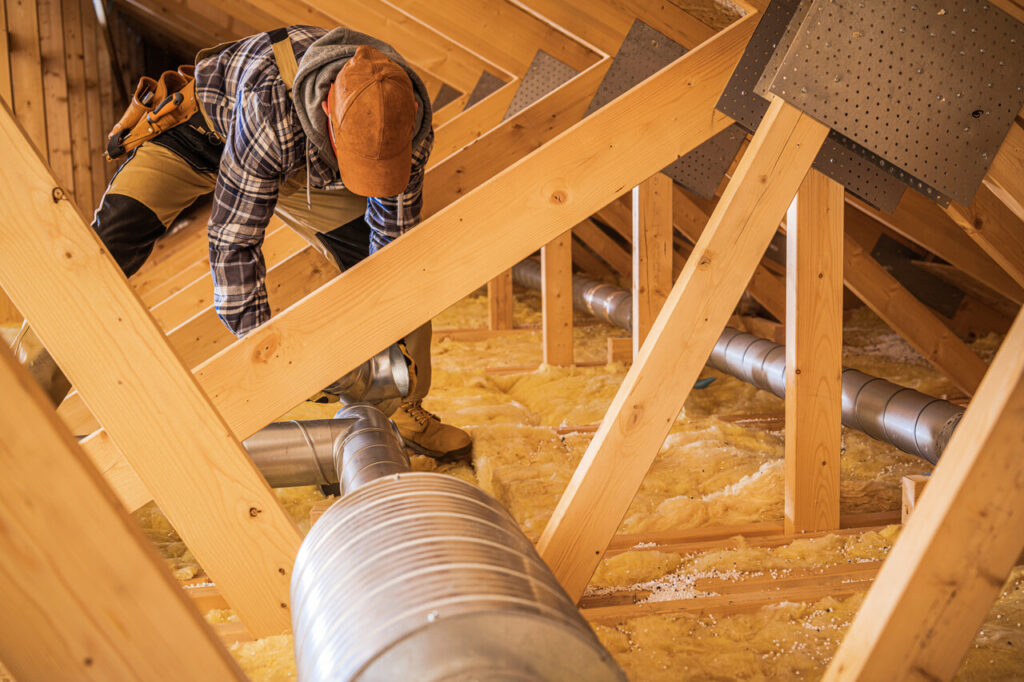Ventilation services have a profound impact on the overall comfort, health, and indoor air quality (IAQ) of commercial spaces. When planning a commercial new construction project, it’s crucial to prioritize a well-designed, efficient ventilation system that promotes a healthy and comfortable environment for occupants. An effective ventilation system helps limit the buildup of harmful air pollutants, controls humidity levels, and enhances energy efficiency in your building.
A well-managed ventilation system can make a significant difference in the overall indoor environment of a commercial property, affecting the health, productivity, and satisfaction of its occupants. Proper ventilation services contribute to cleaner indoor air by reducing the concentration of pollutants, such as carbon dioxide, volatile organic compounds (VOCs), and allergens, which can accumulate in poorly ventilated spaces. Furthermore, maintaining optimal humidity levels within your building can help prevent mold growth, protect valuable assets, and foster a more comfortable space for your occupants.
Perhaps equally as significant, a properly designed ventilation system goes hand in hand with energy efficiency. By selecting the right system for your commercial new construction project and ensuring its proper installation and maintenance, you can optimize your building’s energy consumption while maintaining a healthy, comfortable indoor environment.
Our team of professionals is committed to providing top-tier ventilation services for commercial new construction projects, offering their expertise in system design, installation, and maintenance to help you achieve a well-ventilated and energy-efficient commercial property. Join us as we delve into the importance of proper ventilation services, focusing on the benefits and key considerations for commercial new construction projects. We also outline the expert services offered by our professionals, ensuring your commercial space has a high-performing, tailor-made ventilation system.
Key Considerations for Commercial Ventilation Systems
When designing and implementing a ventilation system for a new commercial construction project, several factors need to be considered to ensure optimal performance, efficiency, and comfort for building occupants. Some of these key considerations include:
- Building Size and Layout: The physical dimensions and configuration of your commercial property will dictate the type, size, and capacity of the ventilation system you require. Our professionals can perform a comprehensive assessment of your building’s unique features to recommend an appropriate ventilation solution.
- Occupancy Level: The number of building occupants and their level of activity plays a crucial role in determining the ventilation system’s demand. A higher number of occupants generates more heat and moisture, as well as contributing to higher levels of CO₂, necessitating a more robust ventilation system.
- Indoor Air Quality Requirements: Depending on the nature of your business, your commercial space may have specific indoor air quality requirements. For instance, specialized spaces such as hospitals, laboratories, and manufacturing facilities would require customized ventilation systems to maintain strict air quality standards.
- Climate and Regional Factors: Local weather conditions and environmental factors should also be taken into account to optimize the ventilation system’s performance and efficiency.
Our experienced professionals can help you navigate these considerations and more to ensure the ideal ventilation solution for your commercial new construction project.
Types of Ventilation Systems for Commercial New Construction Projects
There is a variety of ventilation systems available that can be tailored to suit the specific needs of various commercial new construction projects. Some popular options include:
- Natural Ventilation: By utilizing strategically placed windows, vents, or other openings in the building’s envelope, natural ventilation systems allow the movement of fresh outdoor air into the space without relying on mechanical equipment. This method can be a cost-effective and sustainable choice but may be insufficient for large commercial buildings or spaces with high pollutant levels.
- Mechanical Ventilation: These systems use fans or blowers to draw fresh outdoor air into a building while exhausting stale indoor air. Mechanical ventilation systems provide greater control over air exchange rates and can be customized to meet a wide range of commercial applications. Common mechanical ventilation systems include air handling units (AHUs) and rooftop units (RTUs).
- Heat Recovery Ventilation (HRV) or energy recovery ventilation (ERV): These advanced systems improve energy efficiency by transferring heat (and in the case of ERVs, moisture) between incoming fresh air and outgoing stale air. HRVs and ERVs help maintain a comfortable indoor environment while reducing energy demands on heating or cooling systems.
- Demand-Controlled Ventilation (DCV): DCV systems can further enhance efficiency by adjusting the ventilation rate based on real-time measurements of indoor air quality or occupancy levels. This approach ensures that the building’s ventilation needs are met without wasting energy on unnecessary air exchange.
Whatever your ventilation needs, our experienced professionals can offer guidance and recommendations for selecting the ideal system for your commercial new construction project.
Benefits of Proper Ventilation System Maintenance
Regular maintenance of your commercial ventilation system is essential for several reasons:
- Enhanced Indoor Air Quality: Routine maintenance helps ensure optimal filtration and air exchange, protecting occupants from pollutants and allergens in the indoor air.
- Maintained Energy Efficiency: Regular checkups and cleaning of the ventilation system components, such as fans and air filters, prevent the system from working harder and consuming more energy than necessary.
- Extended Equipment Lifespan: Keeping your ventilation system components clean and well-maintained can extend their useful life, saving costs on repairs and replacements.
- Compliance with Regulations: Certain industries and businesses may be subject to mandatory ventilation standards and guidelines. Regular maintenance and inspections can ensure your commercial property remains compliant with these requirements.
Harness the expertise of our professionals to create a tailored maintenance program for your commercial new construction ventilation system.
Conclusion
Proper ventilation services are crucial for enhancing indoor air quality, promoting energy efficiency, and maintaining a comfortable environment in commercial new construction projects. By understanding the importance of ventilation, exploring various system types, and partnering with our HVAC company in Camdenton, you can ensure your commercial property is well-equipped with a top-performing, customized ventilation system.
Rely on our professionals at Baker Air Conditioning & Heating to provide the expert guidance, system design, installation, and maintenance required to achieve an exceptional commercial ventilation system for your new construction project. Contact us today to learn more about what we can offer and discuss your specific ventilation needs.







